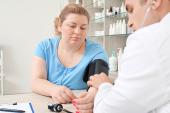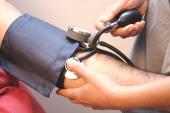Cuff(SZ) Trial Published: One Size Does Not Fit All for BP Accuracy
Miscuffing—measuring BP with the wrong-sized cuff—could result in systolic values off by as much as 20 mm Hg.

To ensure BP readings are accurate, there’s a need for both a wider range of cuff sizes that match patients’ mid-arm circumference and more-consistent ways of measuring that circumference ahead of testing, according to results from the Cuff(SZ) trial.
When the main study results were first presented last year as a poster at the American Heart Association (AHA)’s Epidemiology and Prevention | Lifestyle and Cardiometabolic Health (EPI|Lifestyle) Scientific Sessions, the investigators told TCTMD that “miscuffing” could result in BP differences that are wildly inaccurate and could have serious consequences for clinical management.
Now published in JAMA Internal Medicine, the paper is an extension of the primary analysis and adds robustness to the main message that cuff size matters, said lead author Junichi Ishigami, MD, MPH (Johns Hopkins Bloomberg School of Public Health, Baltimore, MD).
“If you use [a too small] BP cuff size, that will lead to overestimation of blood pressure, whereas if the BP cuff size is larger than it should be, that could result in a lower blood-pressure reading or underestimation of blood pressure,” he told TCTMD.
In a patient for whom the cuff is one size too small, that could translate to a nearly 5-mm Hg difference in systolic BP compared with having a cuff that fits correctly, the study found. When the cuff is two sizes too small, systolic readings could be off by nearly 20 mm Hg. Similar inaccuracies also were seen in diastolic readings, but to a lesser degree.
Despite a 2019 updated scientific statement from the AHA on appropriate BP measurement that highlighted the steps necessary for accuracy, including proper cuff sizing and placement, Ishigami and colleagues say published studies suggest that individual cuff selection is not a common occurrence in clinical practice.
Writing in an accompanying editorial, Mathias Lalika, MD (Mayo Clinic College of Medicine, Rochester, MN), and colleagues say the study “provides more evidence to incentivize the introduction of a wide range of BP cuff sizes to the market.” They add that the findings are especially relevant for underresourced clinics where staff may not be equipped and/or instructed to measure BP correctly.
One option would be to have the US Centers for Medicare & Medicaid Services consider using arm circumference measurement and the range of cuff sizes available as health equity metrics, Lalika and colleagues propose.
“We really need to put the pressure on policymakers to provide an appropriate reimbursement for BP-measuring procedures, including the coverage of multiple BP cuff sizes as well as human resources to implement the recommended procedures,” Ishigami said.
Time constraints likely compound the problem. Staff charged with taking BP have limited time to get accurate pressures before moving on to the next patient and may skip the step of first measuring arm circumference to size the cuff properly. Ishigami said that, in addition to access to a variety of cuff sizes, educational tools are needed to get everyone on the same page to always assess cuff size and measure BP according to guideline-recommended steps.
The Cuff(SZ) Trial
The study included 195 patients (mean age 54 years; 66% female; 68% Black). For each study participant, two sets of triplicate BP measurements were obtained using 1) a regular-size adult automated BP monitor cuff and 2) the cuff that fit their arm best after sizing. Prior to each set of readings, participants were asked to walk for 2 minutes. Patients were seated and BP measurements were started 5 minutes after cuff placement, with no speaking during or between measurements. Each of the three sequential automated measurements were taken 30 seconds apart.
The majority of patients required a large BP cuff (32.1-40 cm) when their mid-arm circumference was measured, with the standard cuff found to be appropriate in only about 28% of patients.
The magnitude of error was shown to increase with increasing cuff size, which Ishigami and colleagues say requires further research to understand the connection.
“Regardless of cause, the potential clinical effect among those requiring larger cuff sizes includes overdiagnosis of not just hypertension, but also stage 2 hypertension,” they write. “The mean BP in those requiring an extra-large cuff based on measured mid-arm circumference was 144/87 mm Hg when a regular BP cuff was used, which is in the stage 2 hypertension range in the US, whereas the mean BP when using an appropriately sized cuff was 125/79 mm Hg, a reading in the elevated BP range. With misdiagnosis to this degree comes additional, likely unnecessary, clinical testing (laboratory and imaging) and treatment, leading to increased cost, psychosocial harm, and risk for adverse events.”
Among the subset of patients who required a small cuff (20-25 cm), using a standard cuff led to BP readings that were a mean of 3.6 mm Hg lower than with the appropriate smaller cuff.
The researchers note that the results from this study of automated BP pressures cannot be extrapolated to manual auscultation.
The editorialists point out that expanding care teams to include community health workers treating medically underserved populations may be one way to allow sufficient time for arm circumference measurement and correct cuff size selection to occur. However, they note that there is also a need for improvement in technology to ensure proper cuff selection and fit.
Digital technologies, such as wearables, mobile applications, and artificial intelligence, can be leveraged to efficiently take arm measurements and determine the appropriate cuff size and shape,” Lalika and colleagues write.
L.A. McKeown is a Senior Medical Journalist for TCTMD, the Section Editor of CV Team Forum, and Senior Medical…
Read Full BioSources
Ishigami J, Charleston J, Miller III ER, et al. Effects of cuff size on the accuracy of blood pressure readings: the Cuff(SZ) randomized crossover trial. JAMA Intern Med. 2023;Epub ahead of print.
Lalika M, Juraschek SP, Brewer LC. There is no 1-size-fits-all to blood pressure measurement—cuff size matters. JAMA Intern Med. 2023;Epub ahead of print.
Disclosures
- The study was supported by Resolve to Save Lives, funded by Bloomberg Philanthropies, the Bill & Melinda Gates Foundation, and Gates Philanthropy Partners, which is funded with support from the Chan Zuckerberg Foundation.
- Ishigami, Lalika, and Juraschek report no relevant conflicts of interest.
- Brewer reported grants from the Bristol Myers Squibb Foundation outside the submitted work.





Comments